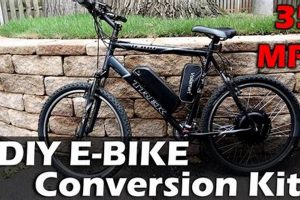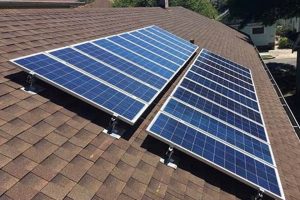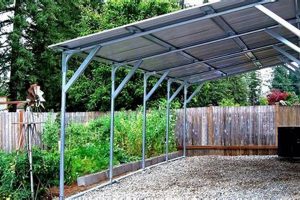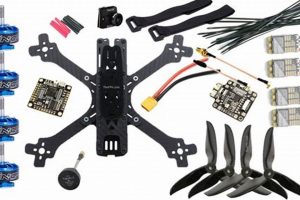A comprehensive solution designed for individuals seeking to apply a protective and aesthetically pleasing coating to their garage floor surfaces is available in pre-packaged forms. These sets typically contain the necessary epoxy resins, hardeners, decorative flakes (if applicable), and application tools, empowering homeowners to undertake the coating process themselves.
Implementing this type of flooring offers several advantages, including enhanced durability, resistance to stains and chemicals, and an improved overall appearance for the garage space. The capacity for individuals to install this flooring themselves offers a cost-effective alternative to professional installation, rendering it a practical choice for budget-conscious homeowners. Its rise in popularity reflects a growing trend toward accessible home improvement solutions.
The following sections will delve into the specific components of these sets, the preparation processes required for optimal application, and best practices for achieving a professional-looking result. Furthermore, we will explore common challenges and troubleshooting tips to ensure a successful installation.
Essential Application Guidance
Effective utilization of an epoxy coating system necessitates careful planning and meticulous execution. The following guidelines are provided to optimize the outcome of the flooring project.
Tip 1: Surface Preparation is Paramount: Thoroughly clean and prepare the concrete floor. Remove any existing coatings, oil stains, or debris. Acid etching or grinding may be required to achieve proper epoxy adhesion. A clean, porous surface is essential.
Tip 2: Temperature and Humidity Monitoring: Epoxy application is highly sensitive to ambient conditions. Ensure that both the air and floor temperatures are within the manufacturer’s specified range, typically between 60F and 90F. High humidity can negatively impact curing and adhesion.
Tip 3: Precise Mixing Ratios: Accurately measure and mix the epoxy resin and hardener according to the manufacturer’s instructions. Incorrect ratios can lead to improper curing, resulting in a soft, tacky, or brittle finish. Use a calibrated mixing container.
Tip 4: Controlled Application Thickness: Apply the epoxy in a consistent and uniform layer, adhering to the recommended thickness provided in the instructions. Excessive thickness can lead to bubbling or cracking, while insufficient thickness may compromise durability. Use a notched squeegee and roller.
Tip 5: Timely Flake Broadcast (if applicable): If decorative flakes are being used, broadcast them evenly across the wet epoxy surface within the designated timeframe. Insufficient flake coverage may result in an uneven appearance. Excess flakes should be removed after curing.
Tip 6: Adequate Curing Time: Allow the epoxy to cure fully according to the manufacturer’s recommended timeframe, typically 24 to 72 hours. Premature use of the floor can damage the uncured coating. Protect the surface from dust and debris during the curing process.
Tip 7: Address Bubbles Promptly: Inspect the freshly applied epoxy for air bubbles. Use a spiked roller to release trapped air immediately after application. Failure to remove bubbles can result in surface imperfections.
Adhering to these guidelines will significantly improve the likelihood of a successful and long-lasting flooring result, maximizing the performance and aesthetic appeal of the application.
The subsequent sections will explore the different types of available coatings, as well as strategies for long-term maintenance and care of the newly finished surface.
1. Surface Preparation
Surface preparation is a foundational element for the effective application and long-term performance of an epoxy garage floor coating. The success of any “diy epoxy garage floor kits” project is inextricably linked to the quality of the preparation undertaken. Insufficient or incorrect surface preparation directly leads to adhesion failures, premature wear, and a compromised aesthetic outcome. For instance, the presence of oil stains or existing coatings prevents the epoxy from properly bonding with the concrete substrate. This results in peeling or blistering, necessitating costly repairs or complete re-application.
The proper preparation involves several key steps. Initially, the floor must be thoroughly cleaned to remove all dirt, debris, and contaminants. Degreasing agents are essential for eliminating oil and grease, while mechanical methods, such as grinding or shot-blasting, create a profiled surface that enhances epoxy adhesion. Acid etching may also be used to open the concrete pores, but it requires careful neutralization and rinsing to prevent interference with the epoxy curing process. A concrete surface with a CSP (Concrete Surface Profile) of 2-3 is generally considered optimal for epoxy application. Ignoring these steps will inevitably compromise the integrity and longevity of the coating system.
In summary, meticulous surface preparation is not merely a preliminary step but a critical determinant of the overall success of a floor coating project. Without adequate preparation, even the highest quality “diy epoxy garage floor kits” will fail to deliver the desired results. Therefore, adherence to best practices in surface preparation is paramount for achieving a durable, aesthetically pleasing, and long-lasting epoxy floor.
2. Epoxy Chemistry
The successful application of epoxy coatings from a “diy epoxy garage floor kits” is fundamentally reliant on understanding the underlying chemical processes involved. The properties of the cured epoxy, including its hardness, chemical resistance, and adhesion strength, are all dictated by the chemical reactions that occur during the curing process.
- Resin and Hardener Reaction
Epoxy coatings are formed by the chemical reaction between an epoxy resin and a hardener (also known as a curing agent). The resin typically contains epoxide groups, which react with the amine or anhydride groups in the hardener. This reaction results in cross-linking, forming a rigid, three-dimensional network. The specific types of resin and hardener used will determine the final properties of the cured epoxy. For example, aliphatic amine hardeners tend to provide good color stability, while cycloaliphatic amines offer improved chemical resistance.
- Stoichiometry and Mixing Ratios
The correct mixing ratio of resin to hardener is critical for complete curing. This ratio, determined by the stoichiometry of the reaction, ensures that all of the epoxide groups in the resin react with the amine or anhydride groups in the hardener. Deviations from the recommended ratio can result in incomplete curing, leading to a soft, tacky, or brittle finish. Manufacturers of “diy epoxy garage floor kits” provid
e precise mixing instructions that must be followed meticulously. - Curing Temperature and Time
The curing process is temperature-dependent. Higher temperatures generally accelerate the curing reaction, while lower temperatures slow it down. Most “diy epoxy garage floor kits” are designed to cure at ambient temperatures, but the curing time can vary depending on the specific formulation and the ambient temperature. Insufficient curing time can result in a partially cured coating with compromised properties. It is essential to adhere to the manufacturer’s recommended curing schedule.
- Additives and Modifiers
Many epoxy formulations contain additives and modifiers to enhance specific properties. These may include pigments for color, fillers for improved strength and wear resistance, flow control agents for better application, and UV stabilizers to prevent degradation from sunlight. Understanding the role of these additives is important for selecting the appropriate “diy epoxy garage floor kits” for a particular application.
In conclusion, a solid grasp of epoxy chemistry is paramount for achieving optimal results when using “diy epoxy garage floor kits”. Understanding the resin-hardener reaction, adhering to precise mixing ratios, controlling the curing environment, and being aware of the role of additives are all essential for ensuring a durable, aesthetically pleasing, and long-lasting epoxy floor coating.
3. Application Technique
The effectiveness of “diy epoxy garage floor kits” is inextricably linked to the application technique employed. Irrespective of the quality of materials within a given kit, improper application will invariably lead to a substandard outcome, characterized by aesthetic imperfections, reduced durability, and potential premature failure of the coating. For example, applying epoxy in excessively thick layers can trap air, leading to bubbling and a compromised finish. Conversely, applying too thin a layer may result in inadequate coverage and diminished protection against wear and tear. The correct technique ensures that the epoxy cures properly, adhering uniformly to the prepared surface and providing the intended level of protection and aesthetic appeal.
Successful application involves several critical steps. Precise mixing of the epoxy resin and hardener, in accordance with the manufacturer’s instructions, is paramount. Utilizing the correct tools, such as notched squeegees and rollers, ensures even distribution and consistent film thickness. The application environment, specifically temperature and humidity, must be carefully controlled to optimize curing. A common mistake is neglecting the “wet edge” during application, leading to visible seams and an uneven surface. Furthermore, the even distribution of decorative flakes, if included in the kit, requires a specific broadcasting technique to achieve the desired aesthetic effect. Mastery of these technical aspects is essential for maximizing the potential of any “diy epoxy garage floor kits.”
In conclusion, while “diy epoxy garage floor kits” provide the materials necessary for coating a garage floor, the ultimate success hinges on a thorough understanding and proper execution of the application technique. Lack of attention to these technical details can negate the benefits of even the highest-quality kits, resulting in a costly and unsatisfactory outcome. Therefore, careful planning, adherence to best practices, and attention to detail are crucial for achieving a durable, aesthetically pleasing, and long-lasting epoxy floor coating.
4. Environmental Conditions
Environmental conditions exert a significant influence on the success or failure of “diy epoxy garage floor kits” projects. Temperature, humidity, and ventilation each play a critical role in the application, curing, and ultimate performance of epoxy coatings. Understanding and controlling these factors is essential for achieving a durable and aesthetically pleasing result.
- Temperature Effects
Temperature directly affects the viscosity and curing rate of epoxy resins. Lower temperatures increase viscosity, making the epoxy more difficult to apply evenly and potentially leading to poor adhesion. Conversely, excessively high temperatures can accelerate the curing process, reducing the working time and potentially causing premature hardening. The ideal temperature range for most “diy epoxy garage floor kits” applications is between 65F and 85F (18C and 29C). Adhering to the manufacturer’s recommended temperature range is crucial for proper curing and optimal performance.
- Humidity Considerations
High humidity levels can interfere with the epoxy curing process, leading to a cloudy or hazy finish, known as amine blush. This occurs when moisture reacts with the amine hardener, forming a waxy film on the surface. Furthermore, excessive moisture can also compromise adhesion by preventing the epoxy from properly bonding with the concrete substrate. It is generally recommended to maintain humidity levels below 75% during application and curing of “diy epoxy garage floor kits”.
- Ventilation Requirements
Proper ventilation is essential during the application of epoxy coatings to dissipate solvent vapors and ensure a safe working environment. Epoxy resins and hardeners can release volatile organic compounds (VOCs) that can be harmful if inhaled. Adequate ventilation helps to reduce the concentration of these vapors, minimizing health risks. Furthermore, good airflow can also assist in the curing process by promoting the evaporation of solvents and moisture. Ensuring adequate ventilation through open windows or the use of fans is crucial when using “diy epoxy garage floor kits”.
- Substrate Moisture Content
The moisture content of the concrete substrate is a critical environmental consideration often overlooked. Excessive moisture within the concrete can lead to blistering or delamination of the epoxy coating after application. The concrete should be tested for moisture content using a concrete moisture meter, and it should be within the manufacturer’s recommended range, typically below 4-5%. If the moisture content is too high, allowing the concrete to dry further or applying a moisture vapor barrier may be necessary prior to applying “diy epoxy garage floor kits”.
In summary, environmental conditions play a crucial role in the success of “diy epoxy garage floor kits” installations. Precise control of temperature, humidity, ventilation, and substrate moisture content is necessary to ensure proper curing, optimal adhesion, and a durable, aesthetically pleasing epoxy floor coating. Failure to address these environmental factors can lead to a range of problems, compromising the performance and longevity of the finished floor.
5. Kit Components
The components included within “diy epoxy garage floor kits” directly determine the quality, durability, and aesthetic outcome of the finished floor. The completeness and quality of these elements are paramount to achieving a successful and long-lasting result. A deficient or substandard component can compromise
the entire project, regardless of the user’s skill or adherence to application instructions.
- Epoxy Resin and Hardener
The epoxy resin and hardener are the foundational elements of any “diy epoxy garage floor kits”. The quality and type of these materials dictate the coating’s resistance to chemicals, abrasion, and impact. Higher-quality resins offer superior durability and longer lifespan. The proper mixing ratio, specified by the manufacturer, is critical for proper curing and the development of optimal performance characteristics. For instance, a kit containing a low-solids epoxy will typically offer less protection than a higher-solids formulation.
- Primer (Optional)
Some “diy epoxy garage floor kits” include a primer designed to enhance adhesion to the concrete substrate. The primer penetrates the concrete pores, creating a stronger bond and preventing delamination of the epoxy coating. The inclusion of a primer is particularly beneficial for older or more porous concrete surfaces. Without a primer, the epoxy may not adhere properly, leading to peeling or blistering, especially under heavy traffic or exposure to moisture.
- Decorative Flakes or Additives
Many “diy epoxy garage floor kits” include decorative flakes or other additives, such as metallic pigments, to enhance the aesthetic appeal of the finished floor. The quality and quantity of these additives can significantly impact the final look. Inconsistent flake distribution or low-quality pigments can result in an uneven or unattractive finish. The presence of UV-stable additives is also important to prevent fading or discoloration over time.
- Application Tools
The inclusion of appropriate application tools is essential for achieving a professional-looking result. “diy epoxy garage floor kits” typically include items such as rollers, brushes, squeegees, and mixing sticks. The quality and design of these tools can greatly affect the ease of application and the uniformity of the coating. For example, a high-quality roller with a suitable nap length will ensure even coverage and minimize the formation of bubbles. The absence of adequate tools can lead to uneven application, streaking, and other imperfections.
In conclusion, the individual components within “diy epoxy garage floor kits” are not merely supplementary items but rather integral determinants of the coating’s overall success. Selecting a kit with high-quality, appropriately matched components and ensuring that all specified materials are used according to instructions is vital for achieving a durable, aesthetically pleasing, and long-lasting epoxy floor.
6. Curing Process
The curing process is a critical phase in the application of “diy epoxy garage floor kits,” directly affecting the final properties and longevity of the floor coating. Curing refers to the chemical reactions that occur after the epoxy resin and hardener are mixed, transforming the liquid mixture into a solid, durable surface. This process is not simply a matter of drying; it involves cross-linking of polymer chains, which determines the coating’s strength, chemical resistance, and adhesion to the concrete substrate. Incomplete or improper curing can result in a coating that is soft, tacky, prone to scratching, and susceptible to chemical damage, rendering the entire application effort ineffective. For example, if a garage floor is subjected to heavy traffic or chemical spills before the epoxy is fully cured, the coating may prematurely fail, requiring costly repairs or re-application.
Adherence to the manufacturer’s specified curing time and environmental conditions is essential for a successful outcome. Temperature plays a significant role; most epoxy formulations require a minimum temperature to facilitate proper cross-linking. Low temperatures can significantly slow down the curing process, while excessively high temperatures may cause the epoxy to cure too rapidly, leading to cracking or other defects. Similarly, humidity levels can affect the curing process, particularly with certain amine-based hardeners, potentially resulting in a surface blush or compromised adhesion. Practical application involves monitoring both air and substrate temperatures, as well as humidity levels, to ensure they are within the acceptable range during the curing period. Furthermore, protecting the coated surface from dust, debris, and moisture during curing is crucial for preventing surface imperfections.
In conclusion, the curing process is an indispensable element of “diy epoxy garage floor kits,” demanding careful attention to time, temperature, humidity, and cleanliness. Failure to manage these variables can negate the benefits of even the highest-quality materials and the most meticulous application techniques. A thorough understanding of the curing process and diligent adherence to the manufacturer’s recommendations are paramount for achieving a durable, aesthetically pleasing, and long-lasting epoxy garage floor.
7. Maintenance Protocols
Effective maintenance protocols are integral to maximizing the lifespan and preserving the aesthetic quality of epoxy garage floors installed using “diy epoxy garage floor kits”. The long-term performance of such floors is directly contingent upon the implementation of appropriate cleaning and care procedures. Neglecting these protocols can lead to premature wear, staining, and ultimately, the need for costly repairs or replacements.
- Regular Cleaning Schedules
Routine cleaning is essential for removing dirt, grime, and debris that can abrade the epoxy surface over time. A schedule incorporating frequent sweeping or vacuuming, followed by occasional mopping with a mild detergent solution, prevents the accumulation of abrasive particles. Abrasive cleaners or harsh chemicals should be avoided as they can damage the epoxy finish. For example, failing to remove spilled oil promptly can lead to permanent staining that is difficult to rectify. Frequency depends on usage patterns; a garage with frequent foot and vehicle traffic necessitates more frequent cleaning than one used primarily for storage.
- Spill Management Procedures
Immediate attention to spills, particularly of oil, grease, or chemicals, is crucial for preventing permanent stains and damage. A prompt cleanup with absorbent materials, followed by cleaning with an appropriate solvent (as recommended by the epoxy manufacturer), minimizes the risk of penetration and discoloration. Allowing spills to linger can result in chemical reactions that degrade the epoxy, compromising its protective properties. The availability of spill response materials, such as absorbent cloths and appropriate cleaning agents, is therefore a necessary component of an effective maintenance strategy.
- Protective Measures Against Abrasion
Implementing measures to minimize abrasion from vehicle tires, tools, and other equipment is essential for preserving the epoxy surface. Using floor mats in high-traffic areas, such as under vehicles or near workbenches, reduces direct contact and prevents scratching. Avoiding dragging heavy or sharp objects across the floor minimizes the risk of gouges and abrasions. Consider the use of furniture pads or sliders for items frequently moved. While epoxy is durable, it is not impervious to damage from constant friction and impact.
- Periodic Inspection and Repair
Regular inspection of the epoxy floor for signs of wear, damage, or delamination allows for timely intervention and prevents minor issues from escalating into major problems. Addressing cracks, chips, or peeling promptly with epoxy repair kits or professional services prevents moisture from penetrating the concrete substrate, which can lead to more extensive damage. A proactive approach to maintenance extends the lifespan of the epoxy floor and minimizes the need for costly replacements.
Consistent adherence to these maintenance protocols ensures that garage floors coated with “diy epoxy garage floor kits” retain their aesthetic appeal and protective properties for an extended period. These procedures represent a relatively small investment of time and effort compared to the potential costs associated with neglecting proper care. The implementation of a comprehensive maintenance plan is therefore an essential component of realizing the full value and long-term benefits of an epoxy garage floor system.
Frequently Asked Questions
The following questions address common inquiries regarding epoxy garage floor coating projects and aim to provide clarity on key aspects of preparation, application, and maintenance.
Question 1: How crucial is surface preparation before applying an epoxy coating?
Surface preparation is paramount. Inadequate preparation results in poor adhesion, leading to premature coating failure. The concrete surface must be clean, dry, and properly profiled for optimal bonding.
Question 2: What is the ideal temperature range for applying epoxy, and why does it matter?
The recommended temperature range is typically between 65F and 85F (18C and 29C). Temperature affects the viscosity and curing rate of the epoxy; deviations from this range can compromise the final coating properties.
Question 3: How do I prevent bubbles from forming in the epoxy during application?
Proper mixing techniques, controlled application thickness, and the use of a spiked roller immediately after application can minimize bubble formation. Ensuring the concrete surface is not outgassing is also important.
Question 4: What is the correct mixing ratio for epoxy resin and hardener, and what happens if it is incorrect?
The manufacturer’s specified ratio must be followed precisely. Incorrect ratios result in incomplete curing, leading to a soft, tacky, or brittle finish, compromising durability and performance.
Question 5: How long should an epoxy floor cure before it can be used?
Curing time varies depending on the specific epoxy formulation and ambient conditions. Generally, allow at least 24-72 hours for light foot traffic and several days for vehicle traffic. Consult the product datasheet for specific recommendations.
Question 6: What cleaning products should be used, and which should be avoided on an epoxy floor?
Use mild, non-abrasive detergents and avoid harsh chemicals, solvents, and abrasive cleaners. Regular sweeping and occasional mopping with a pH-neutral cleaner are generally sufficient.
Effective planning and diligent execution are essential for maximizing the benefits of an epoxy garage floor system.
The subsequent sections will explore potential challenges and troubleshooting techniques associated with these projects.
In Summary
This article has provided a comprehensive overview of “diy epoxy garage floor kits,” examining essential elements such as surface preparation, epoxy chemistry, application techniques, environmental considerations, component quality, curing processes, and long-term maintenance. Understanding these facets is paramount for achieving a durable and aesthetically pleasing result when undertaking such a project.
A properly installed and maintained epoxy garage floor represents a significant enhancement to any residential or commercial space. Homeowners and professionals alike are encouraged to carefully consider the information presented herein before embarking on this endeavor, ensuring a long-lasting and valuable investment. The commitment to quality and meticulous execution will ultimately determine the success of the project.







